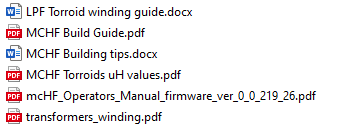With this post, I would like to share my experience with building and using the mcHF QRP Transceiver kit created by M0NKA. I have ordered the v0.6.3 full kit with the matching enclosure in September 2020. Just after placing my order, I got an email confirmation with details on the shipping, a zip file containing a bit of documentation and a link to a YouTube clip by OM0ET, who walks you through the construction of the kit.
My ham-kit building experience from the past includes kits from Elecraft (many of them, K1 & K2 with all options but the K2 DSP), Small Wonder Labs, Softrock, Funkamateur and QRPproject. All of those - regardless of complexity and price point had great documentation. With the mcHF kit I was wondering that there is no assembly manual.

Files included in the documentation bundle
One of the files is a build guide, created by W1BAW for v0.4 boards in 2015. It is a really great document compiled with a lot of effort but it is outdated and for a new builder it is not understandable what the differences between v0.4 and v0.6.3 might be. The guide also has a lot of information on how to solder some of the components but this does not apply to this kit as most of the parts are already pre-soldered.
Also some of the information that was included in the documentation bundle is conflicting with other sources. A few examples of contradicting information:
- Toroid winding count - depending on the source, the number of turns documented differs. The popular YouTube has different values than the kit schematics and again this does not match with a PDF file provided in the documentation bundle.
- The provided documentation states that a SMA connector is used with v0.6.3 boards, but mine came with a BNC connector. SMA connectors on a shortwave QRP radio is an unusual choice anyway.
- Again the listed documents conflict on how to wind the Power/SWR meter bridge.
I have mostly followed instructions from the great OM0ET YouTube video mentioned earlier, all in all, it took me two evenings to complete the kit.
On my unit I was not able to get the SWR meter to really show usable values. In my case that does not matter as I use it with a remote tuner at the antenna feedpoint. Other than that, I did not run into any real issues assembling the kit. There is very little calibration to be done in the software once constructed and although the software is not very intuitive, the calibration is quick. On my unit I can get 15W output on all bands and just a bit below it on 12 and 10 meters. I've set it up for 10W on all bands max.
The kit also has a few features which I did not try, for example the digital voice modes. In fact, I did not even try SSB on the rig, only CW and digimodes. It has a CW decoder which works fine for me on transmit and it is kind of nice to see what you sent. Decoding on the other hand is very flaky and seemed to work on S9+ signals only but I did not bother to tweak the settings for it.
What I like
- Great value for money - what you get is a very usable and versatile 10W, all-band transceiver with CAT-control and integrated audio interface for digital modes. Ten years ago a kit like this and especially at this price point was hard to imagine.
- No transmit/receive relay - no relay clicking and acceptable QSK for my taste, at least at lower speeds (around 20 WPM).
- Plenty output power - 10W is quite a lot of power in CW or digimodes and for my application it can drive my CG-3000 tuner to start tuning. Unfortunately my Yaesu FT-818 does fold back the power in most combinations and therefore can not drive the tuner.
- The waterfall is fast and fluid.
- Physically small package and rugged case.
- Practical kickstand with thumbscrews included - helps with readability when the radio is sitting on a desk.
- I/Q out - can be used as a receiver for CW Skimmer or in other SDR applications.
- RTTY decoding built-in.
- CAT interface emulating the good old FT-817 and is therefore supported by virtually any software.
What could be better
- The kit does not really have proper documentation that I have expected from a kit - while it does come with schematics and PCB layout documentation, it is lacking a real, up-to-date build guide.
- The enclosure is tightly packed and the placement of larger semiconductors is suboptimal, so that accessing the RF PCB requires a bit of time in disassembling/assembling the radio. Personally, I would have preferred a larger enclosure and a larger display.
- The large regulators on my unit dissipate a lot of heat, the enclosure will get warm in that area even when just on receive. Additional cooling is highly recommended for extended periods of transmission with 10W.
- At least my unit is not suitable to drive a Power Amplifier or a transverter, the transmit signal could be cleaner.
- The radio should have self-resetting fuse, as it is not easily accessible in the enclosure.
- Filter bandwidths not customizable in CW, neither is the CW pitch in a practical way. The filters have predefined center frequencies so changing the CW pitch would make for an odd filter.
- VFO encoder is detenting - not sure how much this would add to the overall kit cost and is not a big issue.
- The pre-installed firmware/bootloader was unusable - on my unit the waterfall was not working and I thought I might have damaged something, but after updating the bootloader and firmware to the newest version this went away. The bootloader and firmware are mostly maintained by another group of hams (see UHSDR) and there are their and M0NKA versions out there, so this adds to confusion. Installing a different version of the bootloader required a jumper to be soldered, which again requires partial disassembly of the radio.
In a nutshell
I think overall this is a great, fun radio and quite an evolution of kits in this price range. My biggest complaints are the lack of documentation and un-intuitive software. Once the radio is built and you get used to the user interface you will forget about those issues.
Thank you M0NKA and the UHSDR team for making such a kit available to the ham community.
